Article and all photos by Joe Mock, BaseballParks.com
All rights reserved
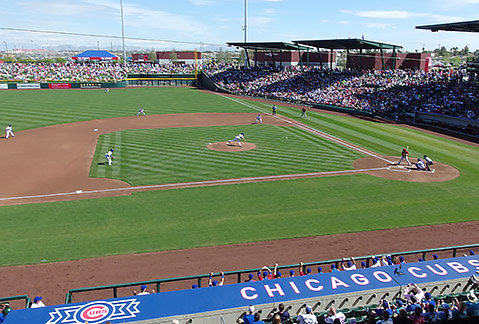 |
The Cubs had grown tired of having their springtime training complex separated from the exhibition-game ballpark by almost a mile. They had grown tired of seeing opulent complexes rise from the desert in Glendale, in Goodyear and especially in nearby Salt River. And they’d especially grown tired of not being able to captain economic development in the rundown neighborhood surrounding HoHoKam Stadium.
| Ballpark Stats |
 |
| Team: Spring Training home of the Chicago Cubs |
| First game: Feb. 27, 2014, a 5-2 loss to the Diamondbacks |
| Capacity: 15,002, of which 9,198 are fixed seats. Berm holds 4,202. Other 1,702 are standing room and group areas. |
| Architect: Populous and DWL |
| Construction: Hunt |
| Price: $84 million for entire complex |
| Home dugout: 3B side |
| Field points: Northeast |
| Playing surface: Tifway 419 Bermuda Grass |
| Betcha didn’t know: Rhino Masonry of Mesa did all of the masonry work on the 315,000 concrete blocks and bricks |
It’s a good thing Cubs fans hadn’t grown tired of making pilgrimages to Mesa every March.
That’s why the opening of the Cubs’ new spring training complex is a win-win-win-win situation: a win for the team; a win for the City of Mesa; a win for Cubs fans who live for watching their team during the spring; and a win for the residents of Mesa, who have proven over and over that they love the team from the north side of Chicago that hasn’t won a World Series since 1908.
Will the new facilities result in an immediate change of fortunes for the lovable losers? Probably not, but it does represent a leap forward for Cubs’ player development.
The way Jason McLeod, the team’s Senior Vice President of Player Development and Amateur Scouting put it to me: “We know this facility won’t turn us into a World Series winner overnight. But given the players we have, this (complex) gives them the opportunity to get better.”
What makes this place special? Is the ballpark at its heart nice enough for a team that calls Wrigley Field home? And does the complex incorporate the kinds of player amenities that really will make a difference in where the Cubs finish in the standings?
Let’s begin our answer to those questions with a little background. The Cubs first came to Mesa to hold spring training in 1952, playing at Rendezvous Park. The modest structure was located near the center of town where the city’s convention center now stands. Dwight Patterson, a successful builder and rancher, is credited with convincing the team to bring their spring operations to Mesa. This is also when the Mesa HoHoKam civic group was formed, and they provided game-day support at the exhibition games. The organization was named for the native American tribe that had populated the area.
The Cubs moved their training camp to Scottsdale in 1965, but then returned to Mesa when the city was able to offer them a substantial place to play their exhibitions. HoHoKam Park, built in a residential area on Mesa’s north side (fitting for the Cubs), was only two years old when the Cubs began playing there in 1979. The playing field was named for Dwight Patterson.
After the spring of 1996, the ballpark was demolished and a new, modern structure (designed by HOK) was constructed. Attendance records fell left and right at the new HoHoKam Stadium, as the Cubs were the biggest draw in Arizona.
But things change.
“The Giants, Rockies and Diamondbacks have all outdrawn the Cubs the past three years,” noted Graham Knight, author of the Arizona Spring Training Ballpark Guide. “Those teams play in newer, flashier stadiums. HoHoKam had become tired and out-of-date. If you were a Cubs fan and went to watch your team play in Salt River Fields or at Camelback Ranch (in Glendale), you would see the open concourses and the accessibility of the players for autographs. You’d come away knowing HoHoKam wasn’t nearly the best of the best any more.”
| Second time a rundown course becomes a field of dreams |
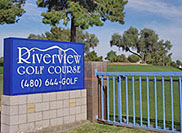 |
| Just like with Salt River at Talking Stick, a fading golf course has been turned into a sparkling new Spring Training complex. Riverview Park Golf Course was closed and in its place has risen the state-of-the-art Cubs complex. |
This development wasn’t lost on the Cubs front office. While they certainly preferred to remain in Mesa, they didn’t want another rebuilding of HoHoKam on the same spot, like they got in 1997. Further, the strain of shuttling players back and forth from the practice fields to the stadium was reaching the breaking point.
The City of Mesa was determined not to lose the Cubs, but progress wasn’t happening quickly enough to suit the ownership group of the Cubs, who had taken over the club in 2009. To hedge their bets, they assessed the possibility of moving their springtime operations to Naples, Florida, not far from where the Red Sox and Twins train.
While many viewed this merely as a ploy to gain leverage over Mesa, this wasn’t the case. One architecture firm told me that the Cubs had come to them to create plans for a new complex in Naples. Fortunately for the Cactus League, the City of Mesa held a vote in 2010 in which citizens were asked to approve the issuing of $99 million in bonds to construct a brand-new facility for the Cubs.
“I was torn about it,” Mesa resident Darlene Emert told me. “I mean, I used to play golf on the course where they were going to build the complex. In the end, though, I voted for it because it was doing what was right for the people and for baseball.” And since no mayor of Mesa wanted to be known as the one who lost the Cubs, Mayor Scott Smith threw all of his political capital behind the referendum.
When all was said and done, it was a landslide, as 70,207 of the 110,341 votes cast were in favor of the expenditure. The Cubs would stay and they would get their new complex, and the Mayor’s job was secure (which he now wants to parlay into Arizona’s governor’s job). “Without Mayor Smith’s political lifting and getting out in front of this to keep the Cubs in Mesa, (the new complex) might not have happened,” Mesa City Manager Chris Brady told USA TODAY Sports.
By no means, though, did the City give the team a blank check. After the bond referendum passed, Brady said that “we told the Cubs ‘we love you, but we’re going to put you on a budget. You have $84 million to spend on everything relating to baseball – the clubhouse, the fields, the ballpark – but we’re going to hold $15 million aside for parking and infrastructure.’” Part of those funds went toward refurbishing a municipal park that was adjacent to where the baseball complex would be built.
Populous was named the architect for the project, and the City hired Hunt to do the construction. Everything went according to schedule, and the players started reporting in mid-February, 2014. When the Cubs took the field for the first exhibition game on February 27, there were many, many smiling faces in the crowd of 14,486, which was the largest single-game attendance in the history of the Cactus League. The first pitch was thrown by Jeff Samardzija, as shown in the top picture on this page. A new era in Cubs history had begun, and the bar had been raised in the state-of-the-art status of spring-training ballparks.
The Setting
“We spent a lot of time studying where to put (the complex),” Brady said. “When you come right down to it, we wanted a unique experience for our residents, the fans.”
Mesa owned a 142-acre parcel of land on which a public golf course existed, as well as youth ball fields and a modest municipal park. Perhaps most importantly, its accessibility was outstanding, as it was virtually in the shadow of the interchange of Loop 101 and 202, two major arteries of the Valley of the Sun. “This space was perfect for the complex and the (improved municipal) park,” Brady explained. “From any point in the Valley, it’s centrally located and very easy for fans to get to. It’s very visible (from the highways), too.”
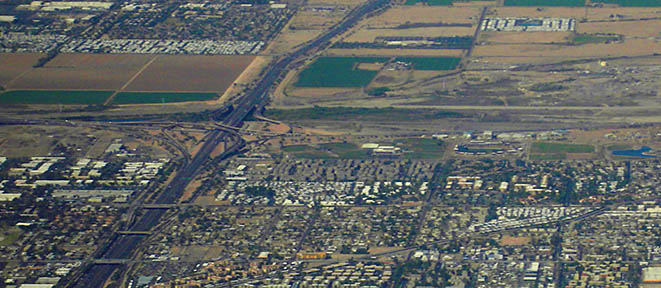 |
I took the shot above as my flight was preparing to land at Phoenix Sky Harbor Airport in October 2013, when I was coming to town to get a first look at the almost-finished project. This gives you a good sense of where the new complex is located, as the major highway running across the shot horizontally is Loop 202. The vertical freeway is Loop 101. The training part of the parcel of land is in the very center of the image.
Perhaps the only downside of the site choice was its proximity to a water treatment plant (below left). Not to worry. Populous designed the facility so as to hide that plant from the view of the fans in the ballpark The backside of the left-field building (and the ad signs and scoreboard) is shown below right. They effectively block the view of the plant.
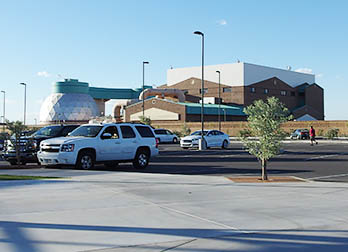  |
The property is bounded on the north by the plant and, ultimately, by Loop 202, also known as the Red Mountain Freeway. Just beyond that super-highway is the perpetually dry riverbed of the Salt River — hence the golf course’s name of Riverview Park. To the east is Dobson Road, along which is a shopping center with a number of restaurants. The southern perimeter is the street called Rio Salada (in English, that’s loosely “salty river”) Parkway. This busy thoroughfare separates the complex from a strictly residential neighborhood. Less than a mile to the west is the large Tempe Marketplace shopping center, with box retailers, movie theaters and more restaurants. Roughly comprising the western edge of the property is the 101, which is known as Price Freeway as it heads south and Pima Freeway as it heads north toward Scottsdale — and Salt River Fields.
Interestingly, about two miles to the west of the Cubs’ new complex is the campus of Arizona State University. This is ironic, because ASU originally entered into an agreement with the Cubs to use Cubs Park for its home baseball games, as well as to have a practice field and training facilities that they would have control of. This all made perfect sense to me, for the following reasons: it would allow ASU to demolish its current baseball facility and use the land for badly needed campus expansion; it wouldn’t hinder students from attending games because it’s so close to the campus; Cubs Park would represent a huge upgrade over ASU’s current baseball stadium; it would utilize the new park with additional games before, during and after spring training.
Well, the agreement between the Cubs and ASU ended before it began, as the two sides hurled nasty allegations at the other, with ASU being particularly critical of the Cubs’ failure to abide by previous commitments. So instead of a perfectly logical arrangement, ASU will move its baseball program to Phoenix Municipal Stadium in 2015. That’s the current spring-training home of the A’s, who intend to move into HoHoKam Stadium (just vacated by the Cubs) in 2015 after it gets a face-lift. There’s a certain symmetry to all of that I suppose.
The new complex itself is laid out with the training facilities at its western end and the revamped (and beautiful) municipal park at its eastern end. To the northeast is a “cloverleaf” of four youth ball fields that are currently being used for parking — and will soon hold a Sheraton hotel. Between the municipal park and Cubs Park are open fields that currently serve as parking lots, but will one day feature a “ballpark village” with retail and eateries. The Cubs’ ownership was very, very interested in the commercial-development possibilities of any new springtime complex it was considering.
The ballpark, as is fitting, is at the very heart of the complex. Unlike the complexes in Surprise, Glendale and Salt River, the team’s clubhouse is not adjacent to the ballpark. The Cubs preferred to have the unbelievably impressive 65,074-square-foot clubhouse building (christened the Under Armour Performance Center in a naming-rights deal announced the day before the first exhibition game) in the middle of the practice fields.
 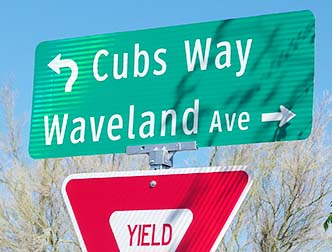 |
This creates the interesting scenario where the players have to traverse a 350-foot path (above left) to go from their lockers to the ballpark to play the exhibitions. McLeod told me that it makes him a little nervous that his high-priced talent has to navigate through a mob of autograph seekers, but “the baseball fan in me thinks it’s pretty cool.”
Another cool aspect of the complex are the street names. On the west side of the ballpark is Clark Street, while Sheffield is the street to its east. Running beyond the park’s left field is, of course, Waveland Avenue. Oddly, there doesn’t appear to be a street there called Addison. If I have to tell you the significance of these street names, then you probably haven’t heard of Wrigley Field.
The Exterior
The exterior of Cubs Park isn’t what you normally find in a spring-training stadium. Instead of a continuous structure around all or part of the park, there are a series of separate and distinct buildings. They all have a uniform look, though, and utilize the desired color scheme for the project: a desert red above natural colored blocks, with Wrigley Field green on the exposed steel.
 |
There are a lot of nice touches on the exterior walls. Near the right-field gate is a large sign painted on the blocks letting everyone know the Cubs play inside and that you’re in Mesa. Many, many fans stop to be photographed in front of this sign (below left).
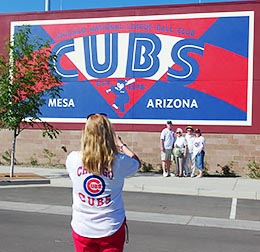 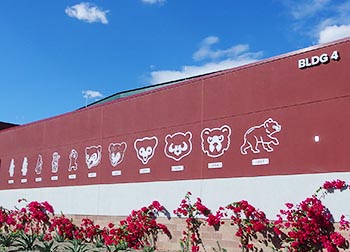 |
There’s also an interesting mural across the walls behind the first-base concourse. It shows the evolution of the Cubs’ logo through the years (above right). If you enter through the right-field or home-plate gates, you might never see it. It’s worth finding.
The entryways are well done without being ostentatious, and all have little touches of Wrigley. The main entrance is behind home plate (below left). Here you can see the color scheme. On the right side below is the first-base gate, with the Wrigley-esque light tower looming over the grandstand.
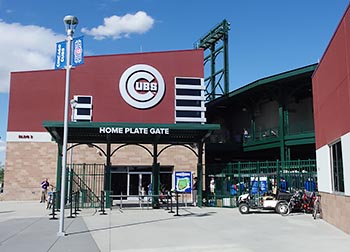 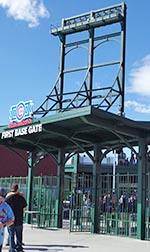 |
The landscaping around the park is appropriate (although the nicest bit of landscaping is inside the park’s footprint), although it falls short of Camelback Ranch and well short of Salt River.
 |
Finally, because the field is a whopping 17 feet below street level, the overall structure has a fairly low profile, as you can see above. The stadium isn’t all that far from Phoenix Sky Harbor Airport, but a spokesperson for Populous told me that this wasn’t the reason for the fairly short exterior. They just wanted the concourse to be on the same level as the streets outside the park.
Let’s now venture inside Cubs Park